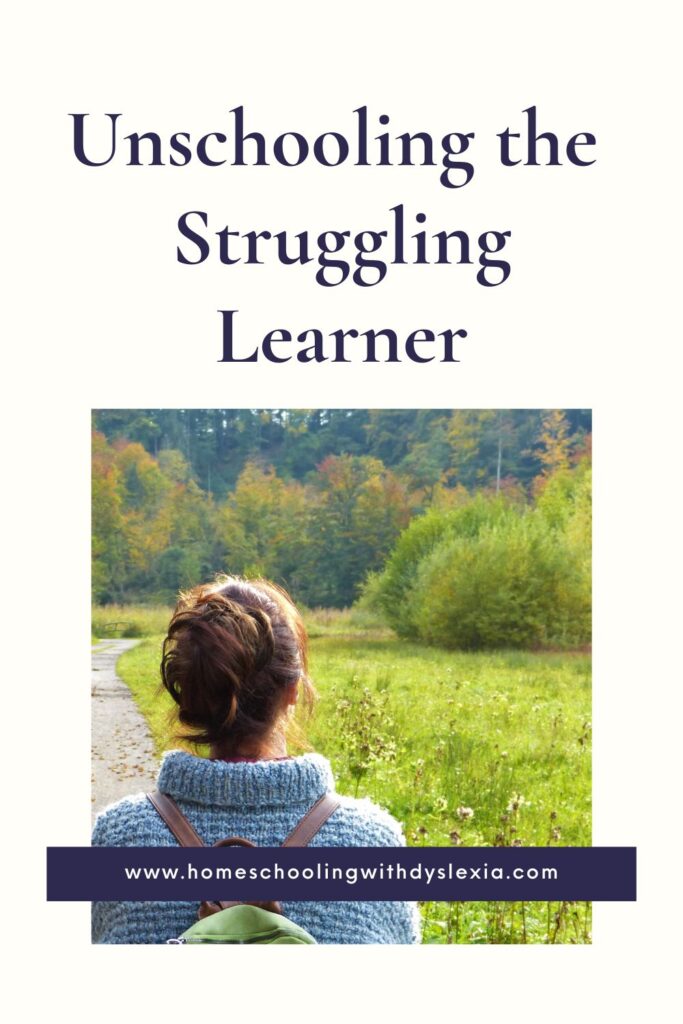Kids struggle with learning for all sorts of reasons. Their struggles can stem from poor (even traumatic) school experiences, illnesses of various types, or learning differences like dyslexia and ADHD. Whatever your story is, unschooling is a great option for all kinds of struggling learners. Here’s why.
Click the player below if you would prefer to listen to this post:
What is Unschooling?
Unschooling is a form of alternative education in which children are not required to follow a traditional curriculum or attend a formal school. Instead, they are free to learn at their own pace and in their own way, often through real-world experiences and activities rather than structured lessons.
The goal of unschooling is to allow kids to pursue their own interests and passions and to learn through experience and exploration rather than through structured classes.
Proponents of unschooling believe that this approach allows children to develop critical thinking skills and to become lifelong learners.
Why Unschooling Works so Well With Struggling Learners
Unschooling is particularly well-suited for nontraditional or struggling learners, as it allows them to learn in a way that is tailored to their individual needs, interests, and learning styles. Some of the ways that unschooling may benefit nontraditional learners include:
- Flexibility: Unschooling allows children to learn at their own pace and in their own way, which can be especially beneficial for children who may struggle to keep up with a traditional classroom setting. They have the freedom to spend as much time as they need on a particular subject or to switch between different subjects and activities as their interests change.
- Personalized learning: Unschooling allows students to focus on the things that they are most interested in, which can help to keep them engaged and motivated to learn. Kids who may struggle with traditional schooling methods or who have specific learning needs can benefit from being able to tailor their education to their own unique needs and interests.
- Real-world learning experiences: Unschooling often involves learning through hands-on experiences and activities, rather than through structured lessons. This can be especially beneficial for children who are more visual, kinesthetic, or hands-on learners, as they may have more opportunities to learn through doing and exploring.
- Collaboration and socialization: Unschooling may also involve opportunities for children to interact with others and learn through collaboration. This can be especially valuable for kids who may struggle to learn in a traditional classroom setting, as it allows them to learn in a more supportive and social environment.

What Does a Day of Unschooling Look Like?
A day of unschooling may look very different from one student to another, as they are free to follow their own interests and pursue their own learning goals. However, some common elements of unschooling include:
- Pursuit of personal interests: Children may spend their time engaged in activities that they are passionate about, such as reading, writing, playing music, creating art, or building with blocks. They may also engage in outdoor activities or hobbies, such as gardening, hiking, or playing sports.
- Real-world learning experiences: Unschooling often involves learning through hands-on experiences and activities, rather than through structured lessons. Children may have opportunities to learn by cooking meals, doing household chores, traveling, volunteering, or participating in community events.
- Flexibility and choice: Unschooling allows children to have a lot of freedom and flexibility in how they spend their time. They may choose to work on a specific project for an extended period of time, or to switch between different activities throughout the day.
- Collaboration and socialization: Unschooling may also involve opportunities for children to interact with others and learn through collaboration. This could include working on projects with siblings, friends, or community members, or participating in group activities such as sports teams or clubs.
Are kids who unschool successful?
It can be difficult to measure success in unschooling, as the goals and outcomes of unschooling may be different from those of traditional schooling. However, there are many examples of people who were unschooled as children and went on to be successful in their careers and personal lives. Some people who were unschooled have become entrepreneurs, artists, writers, musicians, and more.
That being said, it is important to recognize that unschooling is not for everyone, and it may not be the best fit for all children. Some children may thrive in a more structured and formal educational setting, while others may prefer the freedom and flexibility of unschooling. Ultimately, the success of unschooling will depend on the individual child and their unique learning style, interests, and goals.
How to get started unschooling
If you are interested in unschooling your struggling learner, there are a few steps you can take to get started:
- Learn more about unschooling: There are many resources available that can help you understand the principles and philosophy behind unschooling, and how it may differ from traditional schooling. Reading books, articles, and blogs written by unschooling experts and practitioners can be a good place to start.
- Talk to your child: Before you make the decision to unschool, it is important to have an open and honest conversation with them about their thoughts and feelings. Ask them what they are interested in learning about, and what they enjoy doing in their free time. This can help you get a sense of what their learning journey might look like as an unschooler.
- Consider your family’s needs: Unschooling requires a significant amount of time and commitment from parents, as you will be responsible for creating and facilitating your child’s learning experiences. Make sure that you have the resources and support you need to make unschooling a success for your family.
- Create a plan: While unschooling is a flexible and adaptable approach to education, it can be helpful to create a general plan or roadmap for your child’s learning journey. This can include setting goals and priorities, identifying resources and materials, and creating a schedule that works for your family.
- Start exploring and learning: Once you have a sense of your child’s interests and goals, it’s time to start exploring and learning! This may involve trying new activities, visiting museums and other educational attractions, or taking field trips. The key is to keep an open mind and be willing to try new things.
How to unschool in high school
Unschooling in high school can be a challenging and rewarding experience for both parents and students. Here are a few tips for unschooling during this stage:
- Focus on college and career readiness: As your child approaches the end of their high school years, it is important to start thinking about their future goals and how unschooling can help them prepare for college or a career. This may involve identifying skills and knowledge that they need to acquire, and finding ways to demonstrate their learning to colleges or potential employers.
- Create a portfolio: One way to document your child’s learning and progress as an unschooler is to create a portfolio of their work. This can include writing samples, artwork, photographs, and other materials that showcase their interests and achievements. A portfolio can be an important tool for demonstrating the value of unschooling to colleges and employers.
- Consider taking online classes or earning credits through alternative methods: If your child is interested in attending college after high school, they may need to earn certain credits or meet certain requirements. There are many online schools and programs that offer college-level courses for high school students, and some colleges may accept credits earned through alternative methods such as standardized tests or experiential learning.
- Get involved in the community: High school is a great time for your child to get involved in their community and gain real-world experience. Encourage them to volunteer, intern, or join clubs and organizations that align with their interests and goals. This can be a valuable way for them to learn and grow as an unschooler.
- Stay open to new opportunities: As your child progresses through high school, it is important to stay open to new opportunities and be willing to adjust your unschooling approach as needed. This may involve trying new activities, seeking out new resources, or collaborating with others. The key is to remain flexible and adaptable and to support your child as they pursue their passions and interests.
Resources for Unschooling
Here are some of my favorite unschooling resources:
[Book] Unschooled: Raising Curious, Well-Educated Children Outside the Conventional Classroom by Kerry McDonald. Lots of research about unschooling but very readable.
[Website] Unschooling Mom 2 Mom: This is Sue Patterson’s site. She has a ton of articles and other resources on how to best unschool kids of all ages.
[Website] A great list of resources from Denelle at Weed ’em and Reap





0 Comments